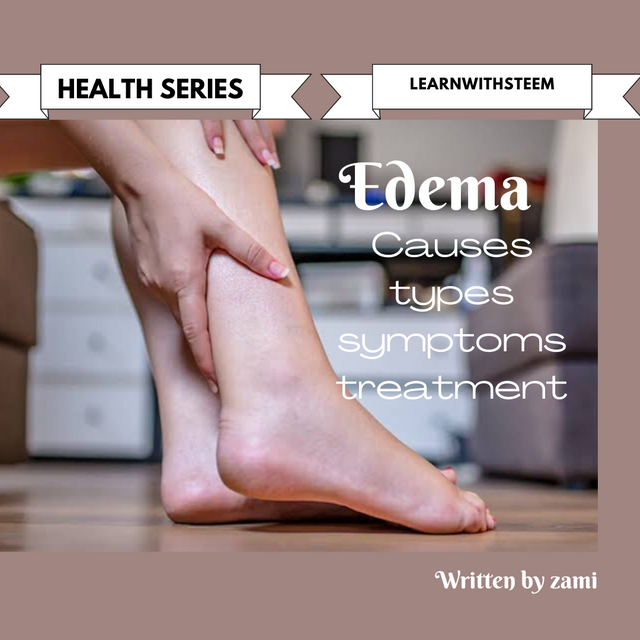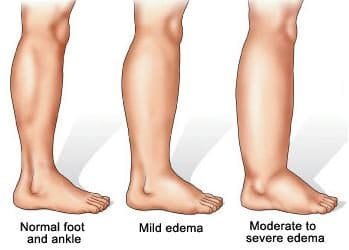Health series; Understanding Edema

Image created on canva
Greetings to everyone, I'm excited to be making another entry on the health series, and the first on @steemkids community, Its my pleasure doing this. Over the weeks, I've churned out great episodes of health series on topics like wicklow, gonorrhea, syphilis, myasthenia gravis, insomnia, etc. You can learn more about any of those topics on my blog.
Today, I'll be writing about a very common disease condition, one that can cause swelling on any part of the body, its known as Edema
What is Edema

source
Edema is a medical condition characterised by abnormal swelling in any part of the body, this is chiefly due to the retention of fluid on the tissue, particularly the skin. This disorder can occur in any part of the body including the arms, ankles and legs. The internal organs like the lungs and cerebrum are not exception.
Edema builds up slowly in the body, it can however occur suddenly, especially when its being caused by an underlining illness like kidney or heart failure. Edema causes the skin to appear puffy and shiny, when pressed, a pit may be formed on the pressed spot, this usually stays for some seconds before disappearing. This types of Edema is known as the pitting Edema.
Pitting and non-pitting edemas are just terms the doctors or medical experts use in ascertaining the severity of the edema so as to determine the appropriate treatment therapy to employ.
Symptoms
The symptoms depends on the area of the body affected as well as the severity of the swelling.
The following symptoms are observed during Edema onset;
- swollen and shinny skin
- Stiff joints and aching body parts
- The skin retains a pit (dimple) after few seconds of applying pressure.
- increase in abdominal size
- reduction in urine production
- visual abnormalities
- shortness of breath
- poor wound healing
- Swollen ankles and face.
Types
There are many types of edema depending on the organ affected. However, most edemas arise as a result of a preexisting disease condition.
The various types of edemas includes;
Pulmonary edema: this type of edema primarily affects the lungs, it occurs when there is a build up of fluids in the lungs. It can lead to breathing difficulty.
Peripheral edema: this type of edema affects only the limbs i.e the hands and the legs. This is the most common of all edemas, It causes swellings in this areas hence making locomotion difficult.
cerebral edema: this types of edema affects the brain causing distortion in neurological functions of the brain.
Macula edema: this type of edema affects the macula. Macula is the part of the eye that enhances central vision.
Causes
There are so many causes of edema ranging from infections to malnutrition. Underlining causes are not left out.
Some causes includes;
hypoalbuminuria (low albumin in the blood); albumin helps in maintaining the oncotic pressure in the body, once this level is distorted, interstitial fluids begins to move away from the blood into the skin tissues.
Liver disease: any time there is a liver disease, liver functions which includes regulation of body fluids is greatly reduced, this leads to the onset of edema.
kidney disease: An individual with a kidney disorder may not be able to eliminate the amount of fluids needed to maintain a proper electrolyte balance in the body, this can lead to fluid retention.
heart failure In situations where the heart cannot pump out blood effectively to the body, blood will start to accumulate in the limbs leading to edema.
Management
Edema can be effectively managed if the right medications are administered.
For peripheral edema, diuretics like hydrochlorthiazide and furosemide can be used in the treatment. For more complicated edemas like cerebral and pulmonary edema, the underlining cause needs to be treated first.
People undergoing treatment should cut down on their level of salt intake, medications like steroids and NSAIDS should be avoided during edema.
Conclusion
Edema is a common occurrence especially among pregnant women. Edema most times occurs as symptoms of an underlining illness like myocardiac infarction and nephrogenic syndrome.
Edema, when left untreated can go as far as damaging the cells of the part it affects, hence, appropriate medical intervention should be sort if symptoms of this disorder becomes evident.
Thanks for reading
10% to @steemkidss
You've got a free upvote from witness fuli.
Peace & Love!
My pleasure
Thank you for contributing to #LearnWithSteem theme. This post has been upvoted by @fabio2614 using @steemcurator09 account. We encourage you to keep publishing quality and original content in the Steemit ecosystem to earn support for your content.
Regards,
Team #Sevengers
Thanks @fabio2614 for finding my post worthy of the sc09 support. Its my pleasure